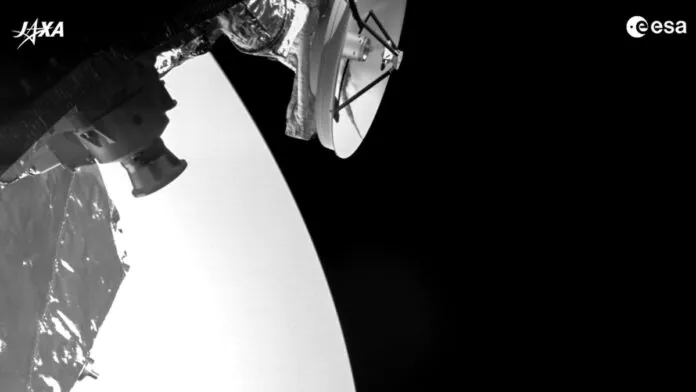© ROOT-NATION.com - Use of content is permitted with a backlink.
A new image released by the European Space Agency (ESA) on Monday (June 27) shows the crater-cut surface of the smallest planet in the solar system, Mercury, captured during the close-up of the BepiColombo probe.
BepiColombo, a joint mission of ESA and the Japan Aerospace Exploration Agency (JAXA), is currently cruising the inner solar system using the gravity of planets including Mercury, Venus and Earth to slow down and enter Mercury’s orbit in 2025.
Fly-over the rocky planet became the second for the probe, as the Mercury will become its final destination. During the first meeting, which took place on October 1, 2021, the probe approached the planet at an extremely close distance – only 200 km. This is closer than the two orbiters that are part of the BepiColombo mission, which will orbit the planet upon arrival.
As BepiColombo approached Mercury from the night side, the spacecraft was unable to photograph the planet at the time of the closest approach. However, other instruments that measured the solar wind in the immediate vicinity of the spacecraft were included on board the two orbiters. The solar wind is a stream of charged particles emitted by the sun that passes through the entire solar system, causing cosmic weather on Earth and other planets.
Both orbiters travel in space enclosed on a transport module, so their high-resolution cameras are hidden and cannot be used during the cruising phase.
The new images show many geological features, including numerous craters, volcanic planes and tectonic cracks resembling rocks. Among the craters recorded by the spacecraft is Caloris Planitia, the largest impact basin on Mercury and one of the largest in the entire solar system. The 1550 km wide crater was formed by a giant asteroid with a diameter of at least 100 km. For comparison, scientists estimate that the asteroid Chixulub, which caused the extinction of dinosaurs about 66 million years ago, was only 10 km wide.

BepiColombo is only the second spacecraft to go into Mercury’s orbit and the third to photograph it. The planet is known to be inaccessible, because any spacecraft traveling to the interior of the solar system is forced to constantly brake against the gravitational pull of the Sun. Therefore, the mission engineers have outlined a long and tortuous trajectory that passes through several celestial bodies, the gravity of which slows down the spacecraft.
NASA Messenger studied Mercury from 2011 to 2015. The probe observed a number of mysterious phenomena, including Mercury’s amazing magnetic field and the existence of ice in shaded craters around the planet’s poles. This ice is stored in these regions, despite the fact that the temperature in the sun-exposed parts of the planet can reach a merciless 420°C. BepiColombo is designed to shed more light on the mysteries of the planet.
You can also help Ukraine fight with Russian occupants via Savelife or via an official page of the National Bank of Ukraine.
Read also:


